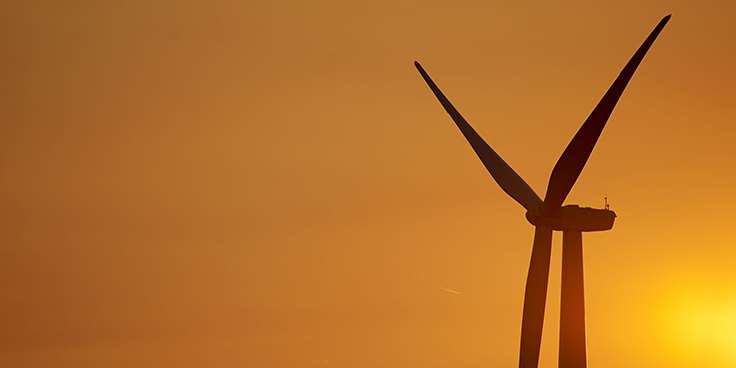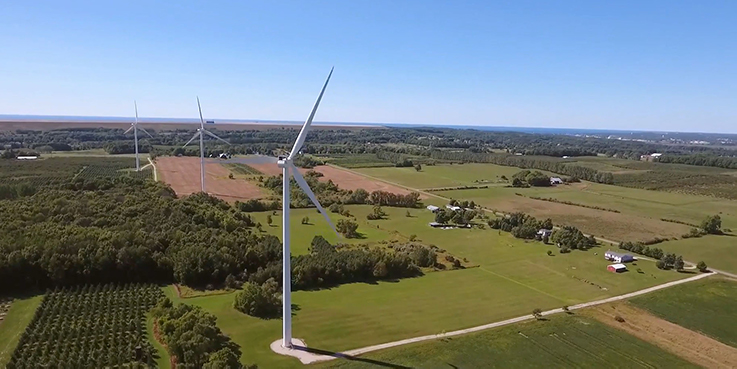Account & Billing
View or pay bill
Billing and Payment
Energy dashboard
Payment Plans & Assistance
Residential Rate Options
Start, Stop or Transfer Service
Account Details
Savings & Clean Energy
Save Money & Energy
Rebates & Discounts
Compare programs
Renewable Energy
Electric Vehicles
Energy Supply Plan
Online Store
Outages & Safety
Report an issue
Safety
Outage Credits
Scheduled Outages
Tree Maintenance
Lake Winds Frequently Asked Questions
Will the wind farm decrease my property value?
Property values are subject to conditions of the local state, or national market. But in 2009, the Lawrence Berkeley
National Laboratory completed a detailed analysis of property values near 24 different wind farms in nine states. The study showed no conclusive evidence of widespread property value impacts in communities surrounding wind energy facilities.
Why did Consumers Energy build Lake Winds® Energy Park?
For two reasons. First, we made a commitment to double our renewable energy capacity from 5% to 10% in 2007 as part of a 25-year Balanced Energy Plan to the Michigan Public Service Commission for meeting the energy supply requirements of our customers. Second, in 2008, Michigan passed a renewable energy standard requiring 10 percent of the state’s energy supply to come from renewable sources such as wind by 2015. We tapped our renewable energy portfolio because it’s the most economical approach, and offers the most value to customers. We’re also developing Cross Winds® Energy Park, a 250-megawatt project in the Thumb area and have contracts to buy about 300 megawatts of renewable energy capacity from third-party suppliers, the majority of which comes from wind.
What is a wind farm?
Clusters of wind turbines that capture and convert wind to electricity. Though it’s easy to imagine a wind farm in one location, turbines are generally spread over thousands of acres of land to maximize production by choosing the ideal locations based on factors such as wind speed and direction.
Why are they putting a wind farm in Mason County?
After carefully studying 19 potential sites in Michigan, we chose Mason County due to the wind resource and because the area offers ready access to available transmission – a key consideration when building a wind farm. Mason County also offers a wind ordinance that ensures public safety while providing the flexibility to develop a highly productive wind farm.
Does the Lake Winds project include or impact Lake Michigan?
No. The Lakes Winds Energy Park site is based entirely on land. The majority of the 56 wind turbines are in Riverton Township and the remainder are in Summit Township.
Why are the turbines placed in southern Mason County?
We completed a detailed wind analysis using data collected by meteorological towers to determine the optimal locations in Mason County. That study showed Riverton and Summit townships hold the most potential for wind production.
Will there be more than 56 wind turbines in Lake Winds Energy Park?
Our special use permit application includes plans for only 56 turbines for the 100-megawatt project, plus four alternate locations. We’ve secured more than 16,000 acres of easements in the two townships, but a good portion of this land is needed to create an underground electric collection system and establish setback buffers to meet zoning requirements for operational factors such as sound and shadow flicker. We have no current plans for further development in Mason County, though an expansion of the state’s renewable energy standard or the creation of a federal standard could necessitate expansion of the Lake Winds project or use of easements dedicated to developing a project in Victory Township.
Will excessive sound or shadow flicker impact me or my family?
The Lake Winds Energy Park is expected to meet or fall well below the Mason County zoning requirements for sound and shadow flicker. In addition, all of the background studies prepared for the special land use permit filing show the project will have minimal environmental impacts, including impacts on migratory birds and bats.
- Sound Parameters: The maximum predicted sound level at an occupied structure located on a participating parcel is 45.5 dBA (county limit = 55 dBA). The maximum predicted sound level at the external property lines of non-participating parcels with an occupied structure will not exceed 45 dBA (county limit = 45 dBA). These levels are lower than commonly used industry standards.
- Shadow Flicker: The project has been laid out to minimize “flicker,” the shadows of rotating turbine blades. Homes near the turbines may experience a few minutes of flicker per day, at some points of the year, but 94 percent will experience only 10 hours total a year or less. We’ll mitigate any shadow flicker at the residence of any unpooled parcel exceeding the maximum zoning requirement of 10 hours per year.
What about the health impact of living near wind turbines?
Wind energy is among the safest ways to generate electricity with the added benefit of no air or water emissions. The American Wind Association in conjunction with the Canadian Wind Energy Association completed a multidisciplinary study in 2009 that concluded wind energy does not present a risk to human health.
Will the area’s wildlife be impacted by placing the wind farm in Mason County?
We’ve taken great effort to have the least amount of impact on animal life. This included two years of wildlife studies based on recommendations from the U.S. Fish & Wildlife Service and the Michigan Department of Natural Resources when considering placement of a wind energy farm in the project area. Avian studies featuring song bird breeding and large bird migration completed by Dr. Joelle Gehring of Michigan Natural Features Inventory were included. No federally endangered or threatened bird species are likely to breed on site. A letter from MDNR indicates that the wind turbines should have no impact on rare and unique natural features. In addition, operation of the wind farm is not likely to have an adverse effect on the Indiana bat, an endangered species, or the eastern pipistrelle, a species of special concern in Michigan based on studies completed by Dr. Allan Kurta of Eastern Michigan University.
Lake Winds® Energy Park
Powering Michigan’s sustainable future with 56 wind turbines in Mason County.
About The ParkFor the best performance on this website and others, please upgrade your browser. For suggestions to find the best web browser for you click here.



